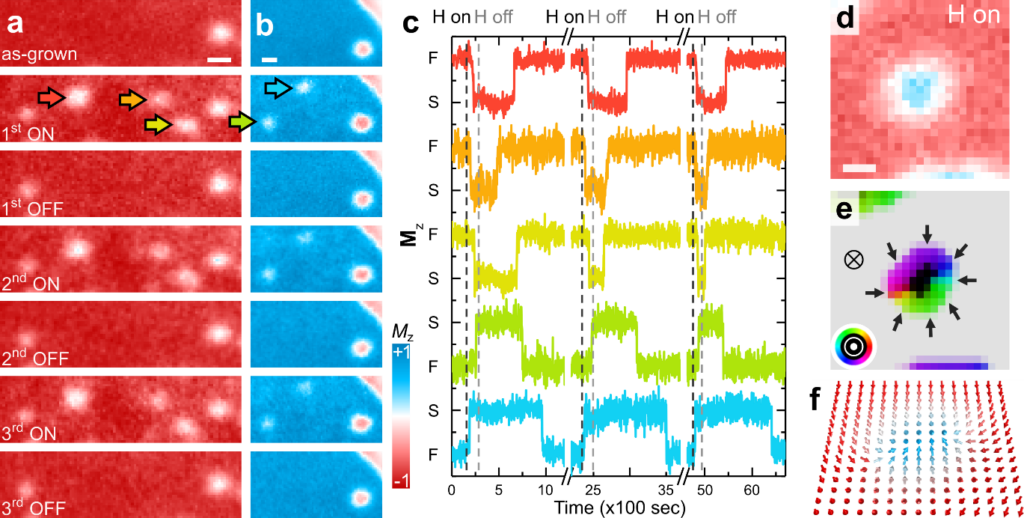Pulling Magnetic Skyrmions out of Thin Air
Magnetic skyrmions are topologically nontrivial spin textures with envisioned applications in energy-efficient magnetic information storage. Toggling the presence of magnetic skyrmions via writing/deleting processes is essential for spintronics applications, which usually require the use of a magnetic field, a gate voltage or an electric current. In a study just published in Nature Communications, Prof. Kai Liu’s group and collaborators, led by Dr. Gong Chen, have demonstrated a new, field-free method to reversibly write/delete skyrmions at room temperature via hydrogen chemisorption/desorption on the surface of magnetic thin films.
Using the spin-polarized low-energy electron microscopy (SPLEEM) facility at the Molecular Foundry of the Lawrence Berkeley Laboratory (LBL), the researchers have observed skyrmion creation and annihilation during hydrogen chemisorption/desorption cycles. They find that the adsorption of less than one atomic layer of hydrogen on the surface of Ni/Co/Pd/W(110) multilayers changes the balance of magnetic energy contributions, particularly the magnetic anisotropy, which in turn drives the skyrmion creation/annihilation as the energy landscape evolves.
Using SPLEEM for magnetization vector mapping, Chen has resolved the spin structure of the written skyrmions and shown that they are left-handed hedgehog Néel-type. Monte-Carlo simulations support the interpretation attributing the reversible skyrmion writing and deleting to anisotropy changes. The roles of hydrogen and oxygen on magnetic anisotropy and skyrmion deletion on other magnetic surfaces are also demonstrated.
Such ambient temperature reversible skyrmion operations in the absence of magnetic field, gate voltage or electric current provide new paths for the design of skyrmion-based spintronics. It adds a new degree of freedom to the emerging field of chiral spintronics, where spin textures may be controlled in a tunable and contactless way, without the need for electrical leads. This may be particularly relevant for three-dimensional information storage schemes involving complex architectures and large numbers of skyrmions, such as racetrack memories. This effect can also be readily integrated into magneto-ionic devices, where the adsorption/desorption takes place at buried interfaces. Such skyrmion-based devices with magneto-ionic functionality may be used for magnetic memory and logic devices, as well as artificial synapses.
Other researchers involved include Alberto Quintana in Liu’s group, Colin Ophus and Andreas Schmid at LBL, Heeyoung Kwon at the Korea Institute of Science and Technology, Changyeon Won at Kyung Hee University, Haifeng Ding at Nanjing University, and Yizheng Wu at Fudan University.
This project was supported in part by the National Science Foundation – Division of Materials Research as well as the Spintronic Materials for Advanced InfoRmation Technologies (SMART) Center sponsored by the Semiconductor Research Corporation and the National Institute of Standards and Technology. The SPLEEM facility was supported by the Department of Energy.
Chen, Schmid, and Liu are co-inventors of a pending patent application on the large Dzyaloshinskii-Moriya interaction and perpendicular magnetic anisotropy induced by chemisorbed species on ferromagnets that relates to this work.

